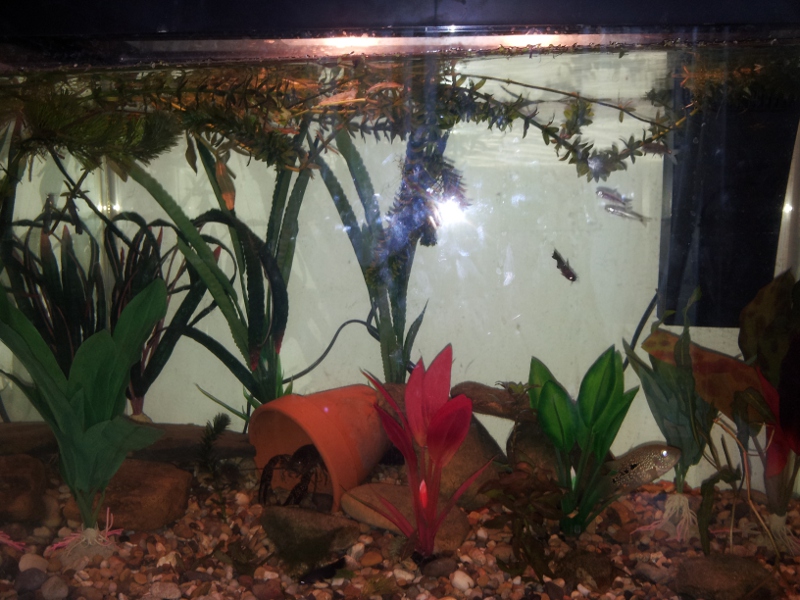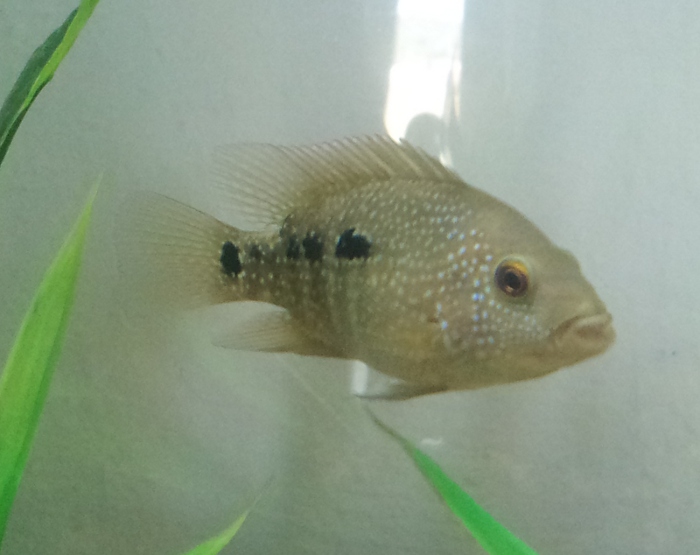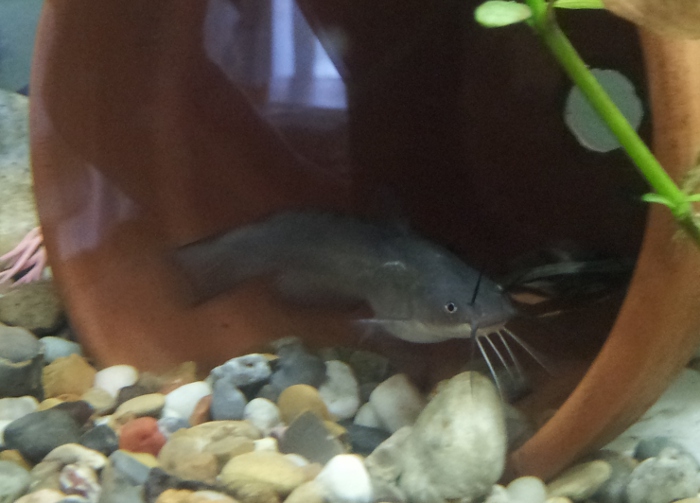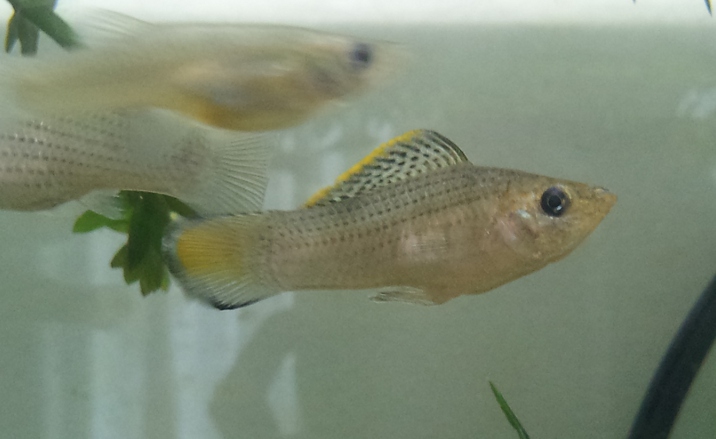I've been keeping aquariums or around them since I was a child, my parents had a 50-gallon with gouramis, angels, cory-cats, loaches, and the occasional oddball like Tire-track (now "peacock") eels and banjo catfish.
I assisted with various tanks in jr. high science, our teacher was a registered wildlife rehabilitator, and we often set up local fauna tanks with crawfish, ghost shrimp, gambusia, frogs, snails, clams (which are a nightmare in the aquaria...I do NOT recommend them)...our most exotic specimen was a lesser siren (2-limbed salamander sort of thing).
I currently have set up a 29-gallon tank with plants from the San Marcos river (Hydrilla, Ludwigia, Cambomba, hair algae). Our tenants are: one 2.5-inch Texas Cichlid, three unidentified catfish fry (maybe black bullhead. started as half-inch "tadpoles", now the largest is 2 inches, after 2 months in captivity, others 1.5 inches), a constantly changing number and assortment of Gambusia and Sailfin Mollies, mainly feeders for the Cichlid.
Tank is filled half with tap water, and half with creek water where most of the fish were collected.
Former tenants: 3-4inch crawfish, released due to eating more of the fish than I would like, and a 1-inch crawfish, eaten by the larger crawfish. Pond snails, eaten by cichlid.
--------------------------------------------
Our summer project has been quite educational for all of us! My boys (ages 14 and 10) are both in public school, but we supplement with many "homeschool" activities, most of our recreation is educational.
First off, I had no idea we had any native cichlids. I was only familiar with the south/central-american, and african species. On a trip to the creek, while I was turning stones, my son netted what he thought was a small "perch" (I'm not sure about the rest of the country, but in Texas, "perch" is to fish what "coke" is to carbonated beverages. Anything not immediately recognizable as a bass, catfish, carp, or minnow is a perch. Also, "minnow" is the generic term used for most small silver-y (bait) fish.) We brought it home with our little cats, put it in the tank, and I got to researching... after many fruitless searches, realized the fins resembled a cichlid more than the perch and sunfish I was looking up. It's grown about a half inch or more in the 2 months or so we've had it. It seems to be doing quite well, cleaned off all the "hairy" rocks I had collected, busies itself with rearranging the gravel and chasing the cats off it's favorite spots, but dosen't otherwise show much aggression to anybody that won't fit in it's mouth. The gambusia are there mostly for food. Anybody that survives should consider themselves lucky, or breeders for more food.
I've had difficulty identifying the baby cats. I found them underneath stones in the rocky creek bed, very shallow running water. We thought they were tadpoles at first, some no more than a half-inch long, and black. Collected 3, they've all survived, and enjoy glutting themselves on whatever food gets left by the other fish, and often coming to the surface to feed with the mollies. Flake food and cichlid pellets.
Above fish and crawfish were all collected in the creeks that run through the city parks in Lockhart, TX.
I also had no idea Mollies were native here! They are my most recent additions, found at Palmetto State Park in Ottine, TX. I noticed fish splashing in a shallow area between a well/fountain and a larger pond that feeds into the oxbow lake, and thought they were young sunfish or perch. On closer inspection I thought they were overgrown Gambusia (I have collected some rather large ones in cattle ponds). After netting and placing in bags, I realized they were Mollies. I was only able to collect females on my first trip-- one large (2.5-3 inch) female and many smaller females. But in the remaining school, I could see several males with brilliantly-colored long fins... gold, orange, and blue, which had me confused since I could not find pictures that matched what I was seeing in wild populations. I assumed them to be pet-shop mollies released and thriving, or some sort of hybrid.
Today was my second trip, and since I had my older son with me, I was able to collaborate and corner more of the mollies amongst the weeds. The larger, dominant males still evaded me, but I was able to collect a few small males, and one large female with an orange patch on her dorsal.
---Question about Mollies:
In Sailfins, do the dorsal fins grow longer with age? The males I collected are very obviously green sailfin mollies, but the fin is fairly short. They are all an inch or less. They may still be adjusting, but none appear to be courting the females yet.
---I just took some fresh pictures to post, and found the large female is not doing well. She was missing a few scales when I introduced them to the tank, now she appears to have a bloody discharge from above and behind the head, I'm guessing a bite from the cichlid, he seems to have her under hack, but not bothering any of the other smaller mollies. I haven't got a secondary tank to move her to right now. Ah, well, I always expect to have a few losses. The younger guys are all doing well.
--------------------------------------------
Photos:
20-gal Tank setup with original incadecent bulbs. This hood did not fit properly and I've since upgraded to a 29g. with LEDs.

The cichlid

The largest of the catfish babies. That's maybe a 3-4 inch flowerpot.

Mollies--
Male, a little over an inch long. This is the most colorful male I caught, there were full-grown ones much more colorful.

Female molly, netted for inspection after being wounded by the cichlid. I have not found any photos of wild mollies with this sort of coloration. Only a few individuals in the colony were colored.

Edited by Frankentrina, 06 August 2014 - 08:06 PM.









